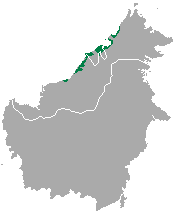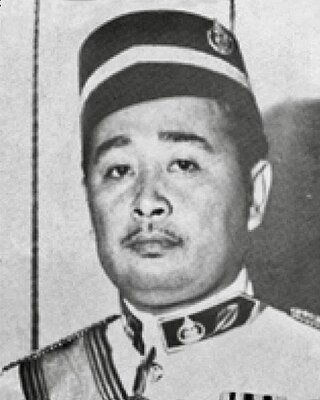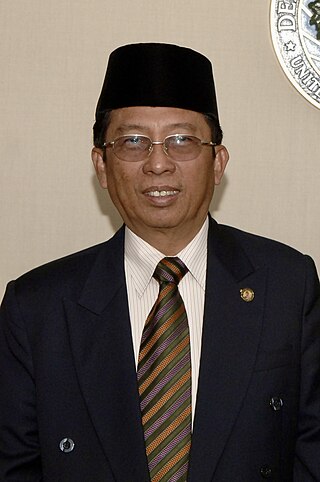
The Kedayan are an ethnic group residing in Brunei, Federal Territory of Labuan, southwest of Sabah, and north of Sarawak on the island of Borneo. According to the Language and Literature Bureau of Brunei, the Kedayan language is spoken by about 30,000 people in Brunei, and it has been claimed that there are a further 46,500 speakers in Sabah and 37,000 in Sarawak. In Sabah, the Kedayan mainly live in the southern districts of Sipitang and Beaufort, where they are counted as a part of the local Malay populace. Whilst in Sarawak, the Kedayans mostly reside in the towns of Lawas, Limbang and Miri.
Saiful Rijal was the sultan of Brunei from 1530 to 1581. He was succeeded by his eldest son Shah Brunei.
Sulaiman ibni Sharif Ali, also known as Senior King and Adipati Agung, was the fifth Sultan of Brunei, according to Silsilah Raja-Raja Berunai. He succeeded his father in 1432 and ruled until his abdication in 1485, to allow his son Bolkiah to become Sultan.

Lun Bawang or Lundayeh is the language spoken by the Lun Bawangs. It belongs to the Malayo-Polynesian family.

The Brunei Malay language, also called Bruneian Malay language, is the most widely spoken language in Brunei and a lingua franca in some parts of Sarawak and Sabah, such as Labuan, Limbang, Lawas, Sipitang and Papar. Though Standard Malay is promoted as the official national language of Brunei, Brunei Malay is socially dominant and it is currently replacing the minority languages of Brunei, including the Dusun and Tutong languages, existing in a diglossic speech, wherein Brunei Malay is commonly used for daily communication, coexisting with the aforementioned regional languages and Malay creoles, and standard Malay used in formal speech; code switching between standard Malay and Brunei Malay is spoken in informal speech as a lingua franca between Malay creoles and regional languages. It is quite similar to Standard Malay to the point of being almost mutually intelligible with it, being about 84% cognate with standard Malay. Standard Malay is usually spoken with Brunei pronunciation.
The Tutong language, also known as Basa Tutong, is a language spoken by approximately 17,000 people in Brunei. It is the main language of the Tutong people, the majority ethnic group in the Tutong District of Brunei.
Abdul Jalilul Akbar ibnu Muhammad Hasan, posthumously known as Marhum Tua, was the sultan of Brunei. His verified reign of 61 years, make the longest of any Bruneian sovereign. An emblematic character of the Age of Absolutism in Southeast Asia.

Pengiran Muhammad Yusuf bin Pengiran Haji Abdul Rahim, pen name Yura Halim, was a Bruneian nobleman, politician, civil servant, diplomat, and writer. He served as the Menteri Besar of Brunei from 1967 to 1972. He wrote the lyrics for Brunei's national anthem, "Allah Peliharakan Sultan," in 1947. The song was adopted as the country's official national anthem in 1951, when it was still a British protectorate. He was longtime member of the Legislative Council of Brunei, serving on the council until his death in 2016.

The Language and Literature Bureau is the Bruneian language authority of the country's official language Malay. It is also the operator of public libraries in the country. It was established in 1960 and is now a government department under the Ministry of Culture, Youth and Sports.

The Tutong people are an ethnic group native to Brunei, mainly in Tutong District. They traditionally speak the Tutong language. They are officially recognised as one of the seven ethnic groups of the Bruneian Malay race.

Cermin Island is an islet at the mouth of Brunei River in the Mukim Kota Batu, Brunei-Muara District, Brunei. During the Brunei Civil War, a battle unfolded on the island and it's sometimes referred to as the Peperangan Pulau Cermin. A proposal for an 5 hectares protection status to be implemented on the island. The island is home to sundry vegetation and swamp forests.

Sufri Bolkiah ibni Omar Ali Saifuddien III is a member of the royal family of Brunei. He is the third son of Omar Ali Saifuddien III, the 28th Sultan of Brunei, and Raja Isteri (Queen) Pengiran Anak Damit. He is also the President of the Brunei Darussalam National Olympic Council (BDNOC) since 2010.

Mohammad Jamil Al-Sufri bin Umar, pen name Wijaya, was a Bruneian aristocrat, historian and teacher who served as a member of the Royal Council, member of the Royal Succession Council, member of the Islamic Religious Council, and member of the Privy Council. He has also been referred to as the National Historian. He wrote works on the country's history, ancestry, customs and traditions, royal titles, Malay Islamic Monarchy (MIB), education, writings on Brunei heroes, and other topics.

Mohammad Zain bin Haji Serudin, pen name Shukri Zain, is a Bruneian aristocrat, politician and poet who formerly held the position of Minister of Religious Affairs from 1986 to 2010. He has traveled abroad and made significant literary contributions to Malay-Islamic literature, including Islamic poetry and usage of his own Malay language to convey his poetic ideas. He also was the leader or president of the Brunei Youth Council (BYL), and a member of the Privy Council.
Nasruddin ibni Besar Abdullah, sometimes spelled Nassaruddin and posthumously named Marhum di Kianggeh, was the self-proclaimed 16th Sultan of Brunei and the grandson of Sultan Abdul Jalilul Akbar. It was under his reign that the first gold coins or pitis were introduced, with the name Nasiruddin Malik al Zahir.

Pengiran Mohammad bin Pengiran Haji Abdul Rahman, pen name Zairis M.S., is a Bruneian politician and writer in the Government of Brunei whole formerly took office as the second Minister of Religious Affairs from 2010 to 2015, and Deputy Minister of Education from 2005 to 2010.

The Istana Darul Hana is one of the few remaining palaces in Brunei which notably, is the former residence of Omar Ali Saifuddien III from 1951 to 1987. The palace is located on a hill at Kilometer 3 of Jalan Tutong in Kampong Tumasek, Brunei-Muara District, Brunei. It is sometimes referred to as Istana Lama.

Muslim bin Haji Burut, pen name Muslim Burmat, was a writer from Brunei who wrote a great deal of literature, particularly novels and short stories that are used in Brunei's educational institutions. In addition to receiving numerous literary honours, his works—which are primarily realistic but also include fresh historiography—showcase aspects of Brunei society.

Mahmud Saedon bin Othman was a Bruneian writer and Muslim scholar. His proficiency in the legal and Islamic domains, served as the foundation for the nation's giving of diplomas in law and Syar'ie law. Additionally, he was the principal advocate for the progressive reinstatement of syariah laws as the supreme law of the nation and the Islamic Legal Specialist in the Ministry of Religious Affairs (MORA).

Barisan Pemuda (BARIP), also known as the Youth Front or Brunei Youth Front, was an early left-wing political party formed in Brunei. It began as a political youth organisation in late 1946 with the goal of bringing the Bruneian Malays together and achieving independence for Brunei. It was said that the three main founders of BARIP were Salleh Masri, Pengiran Yusuf, and Jamil Al-Sufri.

















